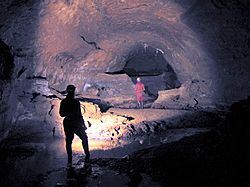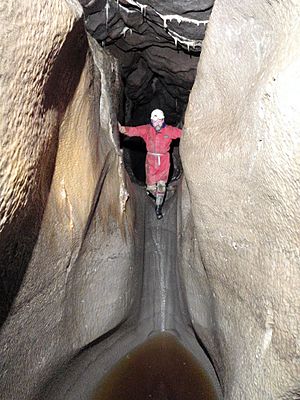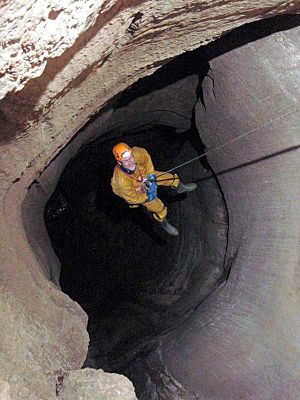Three Counties System facts for kids
Quick facts for kids Three Counties System |
|
|---|---|

Duke Street in Ireby Fell Cavern II
|
|
| Location | North-West England |
| Depth | 249 metres (817 ft) |
| Length | about 86 kilometres (53 mi) |
| Geology | Carboniferous limestone |
| Entrances | 53 |
| Difficulty | Various |
| Hazards | Various |
| Access | Various |
The Three Counties System is a huge network of connected caves found in the north of England. It stretches across three different areas: Cumbria, Lancashire, and North Yorkshire. These caves are made of limestone and were formed by water dissolving the rock over a very long time.
People first thought about connecting these separate caves into one giant system in 1968. This amazing goal was finally achieved in 2011. Today, the Three Counties System is over 86 kilometres (53 mi) long. This makes it the longest cave system in the United Kingdom and one of the longest in the world! Explorers believe there's still much more to discover and connect.
Contents
What is the Three Counties Cave System?
The Three Counties System has many entrances. The southernmost entrance is called Large Pot, located in North Yorkshire. The northernmost entrance is Bull Pot of the Witches, found in Cumbria. These two points are almost 5 kilometres (3 mi) apart! In between, the system passes under areas like Ireby Fell and Leck Fell in Lancashire.
The cave system mostly runs from north to south. Its western side is limited by a natural break in the rock called the Craven Fault. On the eastern side, older rocks cover the limestone. Streams from higher ground flow into holes in the limestone, called swallet holes. Inside the Three Counties System, several major underground rivers flow. All these rivers eventually join up and come out at Leck Beck Head, near Cowan Bridge.
The system is very complex because different parts formed at different times. The landscape and how water drained were different back then. Some parts of the cave are thought to be over 350,000 years old! Other parts are still forming today. The area around the system is so important that it's a Site of Special Scientific Interest. This means it's a special place for studying how land and caves have changed over a long time.
The Three Counties System is 253 metres (830 ft) deep from its highest entrance to its lowest explored point. The highest entrance, Large Pot, is at 402 metres (1,319 ft) above sea level. The lowest point is in Gavel Pot, which has been explored underwater to −64 metres (−210 ft) below that point, reaching an altitude of 149 metres (489 ft).
Main Caves in the System
The Three Counties System is made up of many smaller cave systems. Some of these have several ways to get in. It can be tricky to decide if a cave is a "system" on its own or just part of a bigger one. Here are some of the main cave systems, listed roughly from south to north:
- Large Pot – Rift Pot system – This connects to Ireby Fell Cavern.
- Low Douk – This cave links up with Rift Pot.
- Ireby Fell Cavern – This connects to Rift Pot and also to Notts Pot by cave diving.
- Notts Pot – Notts I connects to Ireby and Notts II by diving. Notts II then links into Lost Johns' Cave.
- Lost Johns' Cave – This connects to Notts II, and to Gavel Pot and Pippikin Pot by diving.
- Short Drop Cave - Gavel Pot System – This links to Lost Johns' Cave by diving.
- Death's Head Hole – Long Drop Cave – This links to Lost Johns' Cave.
- Rumbling Hole – This also links to Lost Johns' Cave.
- Pippikin Pot – This connects to Ease Gill Caverns, and to Witches Cave and Lost Johns' Cave by diving.
- Ease Gill Caverns – This links to Pippikin Pot, and to Bull Pot of Witches by diving.
- Bull Pot of the Witches – This links to Ease Gill Caverns by diving.
- Leck Beck Head – Witches Cave – This links to Pippikin Pot by diving.
History of Exploration
Many of the individual caves that form the Three Counties System were explored long before anyone thought of connecting them all. For example, Lost Johns' Cave was explored in the 1920s. The Ease Gill Caverns System began to be explored in 1946, and Ireby Fell Cavern in 1949.
The idea of the Three Counties System was first suggested by Dave Brook in 1968. He believed that many separate caves from Barbondale in the north to Kingsdale in the south could be part of one huge system. Over the next 43 years, many cavers made new discoveries. These discoveries slowly joined the different cave parts together.
Two very important dates in this journey were:
- May 30, 2010: Rift Pot was connected to Ireby Fell Cavern. This was the first time caves in North Yorkshire were linked with caves in Lancashire.
- November 6, 2011: Notts II was linked to Lost Johns' Cave. This connected the northern part of the system (including caves in Cumbria) to the southern part (including caves in Lancashire). This was the moment the Three Counties System truly became a reality!
Caving can be a challenging and risky activity. Over the years, some people have faced serious accidents while exploring these caves.
Timeline of Discoveries
This timeline shows when major caves were first explored and when different parts of the system were connected.
- 1898: Deaths' Head Hole was fully explored.
- 1898: Short Drop Cave was explored.
- 1899: Bull Pot of the Witches was explored.
- 1928: Lost Johns' Cave was first fully explored.
- 1932: Rumbling Hole was first fully explored.
- 1946: Explorations began in Lancaster Hole – Ease Gill Caverns.
- 1946: Notts Pot was explored.
- 1949: Ireby Fell Cavern was explored.
- 1950: Boundary Pot was explored.
- 1952: Oxford Pot was opened, making it easier to get into Ease Gill Caverns.
- 1952: Top Sink, the highest entrance to Ease Gill Caverns, was first opened.
- 1960: Cow Pot was explored and connected to Lancaster Hole.
- 1965: Long Drop Cave was fully explored.
- 1966: Bull Pot of the Witches was connected to Lancaster Hole by diving. This linked the Ease Gill and Aygill water systems.
- 1969: Lyle Cavern, an old, high-level passage, was explored in Lost Johns' Cave. This was later linked to Notts II.
- 1968: Dave Brook first suggested the idea of the Three Counties System.
- 1970: Gavel Pot was fully explored.
- 1971: Earby Series was explored in Lancaster Hole.
- 1975: Gavel Pot was linked to Lost Johns' Cave by diving. This connected two major water systems on Leck Fell.
- 1976: Ireby Fell Cavern was linked to Notts Pot by diving.
- 1978: Link Pot was explored and connected with Pippikin Pot and Lancaster Hole. This linked cave systems on Leck Fell and Casterton Fell.
- 1981: Long Drop Cave was connected to Death's Head Cave.
- 1982: Lost Pot, an upstream entrance to Lost Johns' Cave, was explored, but then it collapsed.
- 1982: Large Pot was explored.
- 1984: Rift Pot was explored and connected to Large Pot.
- 1985: Rumbling Hole was connected to Lost Johns' Cave.
- 1985: Notts II was discovered by diving.
- 1989: Sylvester Pot was dug and connected to Ease Gill Caverns.
- 1989: Pippikin was linked to Gavel Pot by diving, connecting two important Leck Fell water systems.
- 1997: Witches Cave was connected to Leck Beck Head and Pippikin Pot by diving.
- 2000: Committee Pot was dug into Notts II, making it easier to explore more.
- 2010: Ireby Fell Cavern was linked to Rift Pot. This connected caves in North Yorkshire with caves in Lancashire.
- 2011: Notts II was connected to Lyle Cavern in Lost Johns' Cave. This joined two important Leck Fell water systems and made the Three Counties System a reality.
- 2011: Death's Head Hole was connected to Lost Johns' Cave.
- 2012: Boundary Pot was connected to Ease Gill Caverns.
- 2013: Low Douk was connected to Rift Pot.
Future Discoveries
Even though Dave Brook's dream of the Three Counties System has come true, there's still a lot more to explore! Cavers believe the system can be extended even further in both directions.
To the north, in Barbondale, Aygill Caverns is known to drain into Bull Pot of the Witches. However, no one has yet found a way through the underwater passages to connect them. If this connection is made, it could add another 2.5 kilometres (1.6 mi) to the total system! Even further north, an old passage in Aygill Caverns, called New Year Passage, heads up the Barbondale valley and might connect with other known caves.
To the south, explorations in Large Pot have brought the current system within 500 metres (1,600 ft) of Kingsdale Beck. Another major cave system, Marble Steps, which has large old passages, could also connect to Rift Pot. Marble Steps, parts of Large Pot, and Low Douk Cave are all known to drain to Keld Head. If a diving connection is made there, it could add both the West Kingsdale System (9 kilometres (5.6 mi) long) and the East Kingsdale System (7 kilometres (4.3 mi) long) to the Three Counties System!




